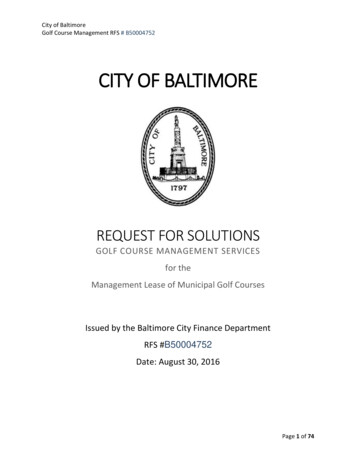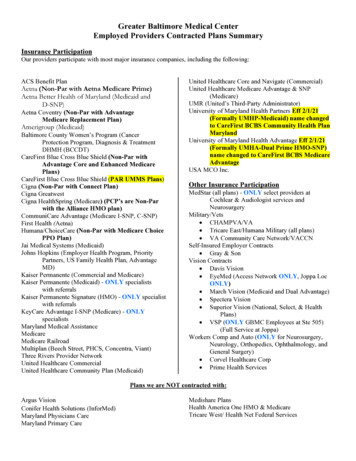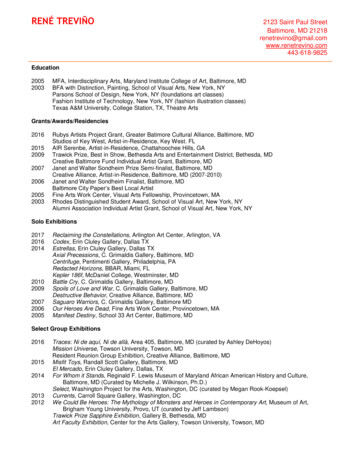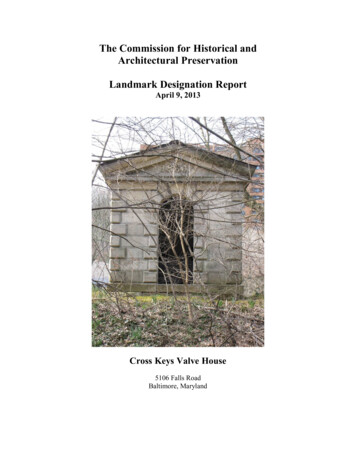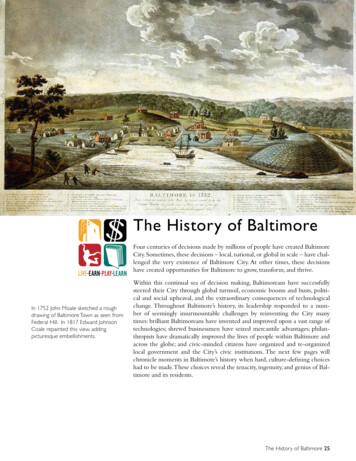
Transcription
The History of BaltimoreFour centuries of decisions made by millions of people have created BaltimoreCity. Sometimes, these decisions – local, national, or global in scale – have challenged the very existence of Baltimore City. At other times, these decisionshave created opportunities for Baltimore to grow, transform, and thrive.In 1752 John Moale sketched a roughdrawing of Baltimore Town as seen fromFederal Hill. In 1817 Edward JohnsonCoale repainted this view, addingpicturesque embellishments.Within this continual sea of decision making, Baltimoreans have successfullysteered their City through global turmoil, economic booms and busts, political and social upheaval, and the extraordinary consequences of technologicalchange. Throughout Baltimore’s history, its leadership responded to a number of seemingly insurmountable challenges by reinventing the City manytimes: brilliant Baltimoreans have invented and improved upon a vast range oftechnologies; shrewd businessmen have seized mercantile advantages; philanthropists have dramatically improved the lives of people within Baltimore andacross the globe; and civic-minded citizens have organized and re-organizedlocal government and the City’s civic institutions. The next few pages willchronicle moments in Baltimore’s history when hard, culture-defining choiceshad to be made. These choices reveal the tenacity, ingenuity, and genius of Baltimore and its residents.The History of Baltimore 25
1729 to 1752 – The BeginningMap showing Baltimore and Jonestown inthe mid-18th Century.There was nothing unusual in 1729 when severalwealthy Marylanders pushed through the State Legislature a town charter for Baltimore. Town charterswere issued routinely across the State in those times.In 1730, Baltimore Town was established with sixtylots, one-acre each, and located on the north side ofthe Inner Basin of the Patapsco River (now the Inner Harbor). These lots were squeezed in between ashallow harbor on the south; the Jones Falls River andmarsh on the east; a bluff and woods on the north; andlarge gullies on the west. In 1745, Jonestown, a smallsettlement just east of the Jones Falls, was merged intoBaltimore, adding twenty more lots to the town. By1752, only twenty-five buildings had been constructedin Baltimore– a rate of approximately one building peryear. Shortly after 1752, the pace changed.1752 to 1773 – Seizing the GeographyThe rise of Baltimore from a sleepy town trading in tobacco to a city rivaling Philadelphia, Boston, and New York began when Dr. John Stevenson, aprominent Baltimore physician and merchant, began shipping flour to Ireland. The success of this seemingly insignificant venture opened the eyesof many Baltimoreans to the City’s most extraordinary advantage– a portnestled alongside a vast wheat growing countryside, significantly closer tothis rich farm land than Philadelphia.The town exploded with energy, and Baltimoreans restructured the City’seconomy based on flour.Trails heading west were transformed into roads; flourmills were built along the Jones Falls, Gwynns Falls, and Patapsco River; andmerchants built warehouses on thousand-foot long wharves that extended intothe harbor. Soon, the roads from Baltimore extended all the way to FrederickCounty and southern Pennsylvania, and Baltimore ships sailed beyond Irelandto ports in Europe, the Caribbean, and South America.The City’s widening reach was also apparent in the foreign-born populations itattracted. In 1756 a group of nine hundred Acadians, French-speaking Catholics from Nova Scotia, made what homes they could in an undeveloped tractalong the waterfront.This pattern would be repeated by numerous groups oversubsequent decades and centuries: entry into Baltimore’s harbor, a scramble forhousing near the centers of commerce, and a dispersion throughout the city asmuch as space, means and sometimes stigma would allow. But not all newcomers started at a disadvantage. During this period, Irish, Scottish and Germanfamilies with experience and capital gained from milling in other parts of theregion, took advantage of the City’s growth economy.1773 to 1827 – Improving on the GeographyDuring the Revolutionary War, Baltimore contributed an essential ingredient for victory: naval superiority. By the 1770s, Baltimore had built the mostmaneuverable ships in the world. These ships penetrated British blockades and26 The City of Baltimore Comprehensive Master Plan (Final Draft)
outran pirates, privateers, and the Royal British Navy. The agility and speed ofthese ships allowed Baltimore merchants to continue trading during the Revolutionary War, which in turn helped to win the war and to propel Baltimore’sgrowth from 564 houses in 1774 to 3,000 houses in the mid 1790s.This engraving of Baltimore waspublished in Paris and New York around1834. Since 1752, Federal Hill has beenthe vantage point from which to viewBaltimore.From the late 1770s through the 1790s, Baltimore was loaded with boomtown energy. Baltimore’s Town Commissioners implemented a number ofcritical public works projects and legislative actions to guide this energy:Fells Point merged with Baltimore (1773); a Street Commission was createdto lay-out and pave streets (1782); and a Board of Port Wardens was created tosurvey the harbor and dredge a main shipping channel (1783). Street lightingfollowed in 1784 along with the establishment of “Marsh Market,” and thestraightening of the Jones Falls. In 1797 Baltimore was officially incorporatedas a city, which allowed local officials to create and pass laws. In 1798 GeorgeWashington described Baltimore as the “risingest town in America” (A.T.Morison, George Washington).Baltimore City at the beginning of the 19th century overcame many obstacles to growth. The northern shoreline of the Inner Harbor was extendedtwo blocks south (Water Street marks the original location of the shoreline)The History of Baltimore 27
Fairview Inn was located on the OldFrederick Road. The inn, known as the“three mile house,” catered to farmersbringing wheat, flour, and produce toBaltimore. This image was painted byThomas Coke Ruckle around 1829.This 1865 view of Fort McHenry waspublished by E. Sachse and Company.Fort McHenry was the military post forBaltimore in the Civil War as well as a jailfor Confederate prisoners.and development expanded in all directions, usually following the turnpike roads that led from Baltimore’sharbor to the rural hinterlands. In1816, when the population reached46,000 residents, Baltimore expanded its boundaries, increasing itssize from three to ten square miles.Shortly thereafter, land surveyorThomas Poppleton was hired to mapthe City and prepare a plan to control future street extensions. His planconsisted of a gridiron street patternthat created a hierarchy of streets:main streets, side streets and small alleys. This set in motion Baltimore’sbasic development pattern of various-sized rowhouses built on a hierarchicalstreet grid. Catering to several economic classes, the larger streets held largerhouses; the smaller cross streets held smaller houses; and the alleys held tinyhouses for immigrants and laborers.As Baltimore’s port grew, its trade routes were extended to the Ohio Valley. In1806 the Federal Government authorized the building of the National Roadfrom the Ohio River to Cumberland, Maryland. In turn, Baltimore businessmen built turnpike roads from Baltimore to Cumberland, effectively completing the Maryland portion of the National Road. The Road quickly becameBaltimore’s economic lifeline to the fertile lands of the Ohio Valley. By 1827Baltimore became the country’s fastest growing city and the largest flour market in the world.At the same time, other economicforces were taking hold. Many millsalong Jones Falls were converted toor built as textile mills. In 1808 theUnion Manufacturing Company,built in the Mount Washington area,became one of America’s first textilemills. Nearly twenty years later, Millsalong the Jones Falls were producing over 80% of the cotton duck (sailcloth) in the country. In addition, 60flour and grist mills, 57 saw mills, 13spinning and paper mills, 6 foundries,and 3 powder mills were located onstreams near the City, and shipyards,brick kilns, copper and iron works,and glass factories were built alongthe shoreline of the harbor.Baltimore also played a key role in the War of 1812. Privateers, essentially pirates supported by the U.S. government, played a decisive role in winning theWar. At this time Baltimore shipbuilders built the fastest, most maneuverableships in the world. Known as the “Baltimore Clipper,” these ships allowed Bal-28 The City of Baltimore Comprehensive Master Plan (Final Draft)
timore ship captains to wreak havocon England’s maritime trade. CaptainW.F. Wise of the Royal Navy said “InEngland we cannot build such vesselsas your ‘Baltimore Clippers.’ We haveno such models, and even if we hadthem they would be of no service tous, for we could never sail them asyou do.” Of the 2,000 English shipslost during the war, Baltimore privateers had captured 476 or almost 25%of them.The British described Baltimore as‘a nest of pirates,’ and the City soonbecame a military target. After theBritish burned Washington, DC, theysailed to Baltimore. The City, left todefend itself, looked to Revolutionary War hero General Samuel Smithto coordinate its defense. Following Smith’s direction, every able-bodied mantoiled for days, building a formidable defense at Hampstead Hill (now Patterson Park) and making preparations at Fort McHenry. A contemporary of Smithquipped “Washington saved his Country and Smith saved his City.”The Battle of Baltimore has been immortalized by not one but two Americantreasures. The Battle Monument erected between 1815 and 1825 was the firstpublic war memorial in the country and the first memorial since antiquity tocommemorate the common soldier. It lists every ordinary citizen who died inthe battle. In addition, Francis Scott Key, who was being held prisoner on a British ship, observed the battle and recorded the event in a poem, which he set tothe tune of an old drinking song. The Star Spangled Banner premiered in Baltimore in 1814 and became our National Anthem in the early 20th century.As Baltimore grew in size and population, many social and cultural institutionswere founded. As early as 1773, a theater opened in an old warehouse near current-day Power Plant Live. By 1800there were three theaters and severaltheater companies. In 1797, directlyacross from the current-day CityHall, the Baltimore Dance Club builtthe New Assembly Room featuring aball room and a subscription library.In 1814, Rembrandt Peale built thefirst purpose-built museum buildingin the Western Hemisphere and thesecond in modern history. The PealeMuseum exhibited paintings, sculpture, and the bones of a mastodonexcavated in upstate New York. During the first half of the 19th century,Baltimore’s cultural activities grew asliterary, science and social clubs wereformed.In 1829, the Baltimore & Ohio (B&O)Railroad built the Mount Clare Station.By 1900 it was a sprawling complex of32 buildings. This building, the MountClare Passenger Car Shop, built in 1884,became the B&O Railroad Museum’sprincipal building in 1953.The Washington Monument in 1835 saton the grounds of “Howard’s Woods.”Baltimore’s developed area ended ablock south on Charles Street.The History of Baltimore 29
The early 19th century was a great time for Baltimore. It seemed to be America’s perennial boom town. It kept growing. It had energy. It was a city full ofmerchants of all kinds. Its sailing ships were the fastest, swiftest force on theworld’s oceans. In the 1830 national census, with its population of 80,000, Baltimore had become the second largest city in the United States. German settlersnow made up a substantial part of this population (possibly some ten percentas early as 1796). Substantial numbers of Scotch-Irish moved overland fromPennsylvania while boatloads of newcomers from Ireland, Scotland and Francewere received as well. A number of the new French-speaking arrivals came byway of the Caribbean from Santo Domingo (present-day Haiti), displaced bya massive and ultimately successful slave revolt. The blacks among them mayhave added as much as 30% to the “colored” population of the town.1827 to 1850 – The Looming Economic DownturnPortrait of Frederick Douglass. Douglassspent his early years in Baltimore wherehe learned to read and write. In the late1830s, Douglass escaped to freedomwhile impersonating a sailor.In 1825, one boat completed a journey that indirectly shaped Baltimore’s history for the next 100 years. The packet boat, Seneca Chief, operated by NewYork Governor Dewitt Clinton, journeyed from the eastern end of Lake Erieto New York City, thereby inaugurating the Erie Canal. A year later, 19,000boats had transported goods to and from the Midwest and New York.The newfreight rates from Buffalo to New York were 10 per ton by canal, compared tothe cost of 100 per ton by road.The canal became by far the most efficient andaffordable way to transport goods from the Midwest to the Atlantic Ocean.As trade on the canal began to usurp trade on the National Road, Baltimoreansforesaw the City’s economic power eroding. Baltimore’s business leaders wereon the verge of panic. They discussed all sorts of wild schemes and alternativecanal locations, but Baltimore’s geography prevented any of these schemes frombecoming reality.At this point, the luck and stubbornness of Baltimoreans began a course ofevents that reinvented the world, even making its arch nemesis, the Erie Canal,obsolete. Baltimore merchant Philip Evan Thomas while in England becameconvinced that England’s “short railroads,” which hauled coal from the minesto the canals, had long-distance potential. On February 12, 1827, Thomas and25 other Baltimore merchants met “to take into consideration the best meansof restoring to the City of Baltimore that portion of the western trade whichhas lately been diverted from it by the introduction of steam navigation [onthe Mississippi] and by other causes [the Erie Canal].” Four days later, the menresolved “that immediate application be made to the legislature of Marylandfor an act incorporating a joint stock company, to be named the Baltimore &Ohio Railway Company.” Twelve days later, the Act of Incorporation for thecompany was approved.Over a year later, on July 4, 1828, with 4,000,000 of capital stock alreadyraised, Charles Carroll of Carrollton laid the “first stone” of the B&O Railroad. On May 22, 1830, the B&O Railroad began running operations fromBaltimore to Ellicott’s Mills, a distance of 13 1/2 miles. Finally, on December24, 1852, the last spike was driven in Wheeling,Virginia (now West Virginia), adistance of 379 miles.In those few years, Baltimore citizens had decided how far apart the rails shouldbe (4 feet 8 1/2 inches), had completely re-engineered the steam engine, and infact had created the world’s first long distance railroad, the world’s first passenger30 The City of Baltimore Comprehensive Master Plan (Final Draft)
railroad, and the world’s first railroad that climbed over mountaintops. At the B&O railroad shopsin West Baltimore, ingenious innovators perfected passenger andfreight car design, continuouslyimproved the steam locomotivedesign, and fabricated bridges forthe growing railroad. Baltimoreans unleashed “mighty forcesthat were to revolutionize landtransportation, alter the courseof trade, make and unmake greatcities, and transform the face ofthe country” (J. Wallace Brown).The B&O Railroad shops triggered technological innovationin architecture and engineering.Wendel Bollman, after workingas an engineer for the B&O Railroad, developed the first cast-ironbridge system in the country. In1850, the Hayward, Bartlett & Company, iron fabricators, moved next to theB&O Railroad shops and began producing much of the nation’s cast-iron architectural components.An 1848 image of the WashingtonMonument from Charles and Hamiltonstreets. The squares were first laid out assimple lawns.The telegraph became intertwined with the development and success of theB&O Railroad. In 1844, a telegraph line was completed from Baltimore toWashington, DC along the B&O Railroad tracks. First the telegraph lines wereburied, but the lines kept failing. Finally, they were strung on poles, effectively bringing into existence the telephone pole. Later, the railroads and thetelegraph, together, helped to implement standard time zones throughout theCountry. Standard time zones were essential for railroads to safely scheduletheir trains, and the telegraph allowed cities across the country to synchronizetheir clocks.The railroad’s first year of operation coincided with a spike in immigration.The port’s intake of foreigners doubled in 1830 and again in 1832, from 2,000to 4,000 to 8,000 per year. Bavarian Jews, for example, settled in Oldtown onHigh, Lombard, Exeter and Aisquith streets.1850 to 1866 – Baltimore at Mid-CenturyBetween 1850 and the Civil War, extraordinary changes spread through Baltimore’s landscape. Cast-iron building technology transformed Baltimore’s downtown. In 1851 the construction of the Sun Iron Building introduced cast-ironarchitecture to Baltimore and the nation. Its five-story cast-iron façade, ironpost-and-beam construction, and sculptural detailing were copied throughoutcities worldwide. Back in Baltimore, 18 months after the Sun Building opened,22 new downtown buildings incorporated cast iron into their construction. In1857 the Baltimore Sun noted, “literally, the City of yesterday is not the city oftoday The dingy edifices that for half a century have stood are one by onebeing removed, and in their places new and imposing fronts of brown stone oriron present themselves.”The History of Baltimore 31
An 1850s-era view of Mount VernonPlace in relation with downtownBaltimore.Baltimore was also remarkable during this time for the size and achievementsof its African-American community. In 1820 it was the largest in the nation.Slave or free, no greater number of blacks could be found anywhere in thenation. By the time the Civil War erupted, the City contained 26,000 freeblacks and approximately 2,000 slaves. Even more remarkable, during thatsame period Maryland alone accounted for one out of every five free blacksin the country.African Americans struggled for a piece of Baltimore’s economic activities.Prior to emancipation, it was common for slaves in the City to rent their skillsand services for wages, part of which went to their masters and part of whichcould be used for food, accommodation and amusement. At the same timeracism handicapped free blacks while competing with whites for skilled andunskilled jobs in the port economy. During times of recession, white workingmen sometimes resorted to violence to keep jobs among themselves.1866 to 1899– Heading Towards ModernityAfter the war, the City’s industry gathered momentum. The advent of steampower in the 1820s released Baltimore’s industry from its stream valleys, andnew larger-scale industries were built close to the harbor. Baltimore’s connections to the Bay’s fishing industry and the fertile farm land around the Chesapeake Bay helped to concentrate canning factories around the harbor’s edge. Infact, by the 1880s, Baltimore had become the world’s largest oyster supplier andAmerica’s leader in canned fruits and vegetables. Complementing the canning32 The City of Baltimore Comprehensive Master Plan (Final Draft)
industry was the fertilizer industry. Baltimore became the number one importer of guano, centuries-old bird droppings scraped off Pacific Coast islands nearSouth America. Mixed with phosphates, guano became the most importantfertilizer for the farms lining the Chesapeake Bay. By 1880, Baltimore had 27fertilizer factories producing 280,000 tons of fertilizer per year.Immigrants waiting to debark at LocustPoint. Close to two million immigrantsarrived in Baltimore throughout the19th and early 20th centuries. (Courtesyof the Maryland Historical Society,Baltimore, Maryland)Baltimore was also becoming a leader in other manufacturing sectors. By the20th century, the City was a world leader in manufacturing chrome, copper,and steel products. In 1887, Sparrow’s Point was developed by PennsylvaniaSteel Company. This location brought Cuban iron ore and Western Marylandcoal together, creating a company that helped to shape Baltimore’s economyfor over a hundred years. In addition, Baltimore was America’s ready-madegarment manufacturing center and the world’s largest producer of umbrellas.Baltimore grew on its manufacturing strength, and industry expanded alongthe shorelines of Fairfield, Brooklyn, and Curtis Bay.From 1850 to 1900 Baltimore’s population grew from 169,000 to 508,957.Baltimore’s vibrant and diverse neighborhoods evolved to accommodate aconstant influx of immigrants searching for opportunity. More than two million immigrants landed first in Fells Point and then in Locust Point, making the City second only to New York as an immigrant port-of-entry. MostThe History of Baltimore 33
new arrivals promptly boarded theB&O Railroad and headed west, butmany stayed in the City to work inthe burgeoning industries or starttheir own businesses. Irish, German,Eastern European, Greek and Italian immigrants added their customs,religions and talents to Baltimore’scolorful tapestry of neighborhoodsand industries.Baltimore Harbor image of LocustPoint and Canton around 1860. Imagesof Camden Station (left) and the oldCalvert Street Station (right) are locatedin the upper corners of the picture.This growth, however, placed greatpressure on Baltimore’s physicalinfrastructure, and City officialsresponded. To accommodate thisgrowth, Baltimore expanded its sizefrom ten to thirty square miles in1888. Prior to this annexation, theCity influenced the suburban regions through the Baltimore CityWater Works and the developmentof the horsecar.In 1853, the Baltimore City government purchased the Baltimore Water Company. With Baltimore’s water supply clearly a government responsibility, ambitious plans were implemented. Between 1858 and 1864, the Hampden Reservoir, Lake Roland and Druid Lake were created. This water system used theJones Falls as its source; however, in 1874 the City passed an ordinance to createanother water system with the Gunpowder River as its main source. By 1888,Baltimore had created Loch Raven Reservoir and a seven-mile tunnel thatconnected Loch Raven to Lake Montebello.In addition, horsecar railway companies began laying track along Baltimorestreets in 1859. Many horsecar railway lines followed old turnpike roads, effectively opening up suburban areas for development. In a matter of yearsBaltimore’s neighborhoods and its suburban villages were tied together bya comprehensive system of horsecar railway lines. In the 1890s, Baltimorereplaced horsecars with the electric streetcar, which opened up even moresuburban areas to development, and by 1900 over 100 suburban villages surrounded Baltimore.While horsecars expanded Baltimore’s physical reach, steamships and railroadstied Baltimore to the global economy.The B&O Railroad connected Baltimoreto the West; the Philadelphia, Wilmington and Baltimore Railroad connectedthe City to Philadelphia; and the Maryland and Potomac Railroad connectedBaltimore to the South. As early as 1851, Baltimore steamship companies connected the City to points along the shoreline of the Chesapeake Bay. In 1869,Baltimore and Bremen businessmen opened the Baltimore Bremen Line, whichbegan regular runs between Baltimore and Germany. Samuel Shoemaker, anenterprising Baltimorean, seized the opportunity that Baltimore’s transportation hub offered. He helped to organize the Adam’s Express Company thatprided itself on delivering anything, anywhere.This service helped to open andsettle the West. By the 1880s the company employed over 50,000 people.34 The City of Baltimore Comprehensive Master Plan (Final Draft)
Closer to home, Mayor Swann agreed to allow horsecar companies to lay trackon public streets in exchange for 20% of their gross proceeds to fund a parksystem. In 1860 Baltimore created its first park board and opened Druid HillPark. By 1900, the Park board had added eight major parks to Baltimore. Allthese parks were incorporated into Baltimore’s major park plan of 1904.A lithograph of City Hall in 1875 byA. Hoen Company.As of 1893, Baltimore had more millionaire philanthropists than any other cityin America; moreover, through the benevolence of four Baltimoreans, modernphilanthropy began. In 1866 the Peabody Institute opened with a music school,an art gallery, a lyceum, and a library more comprehensive than the Library ofCongress. Picking up on these themes, Enoch Pratt founded the City’s librarysystem; William and Henry Walters founded the Walters Art Gallery; and JohnsHopkins founded Johns Hopkins University and Hospital. During one memorable dinner, John Work Garrett remembers George Peabody telling JohnsHopkins, “I began to find out it was pleasanter to give money away than it wasto make it.”“My library,” Mr. Pratt said, “shall be for all, rich and poor without distinctionof race or color, who, when properly accredited, can take out the books if theywill handle them carefully and return them.” In 1886 with the opening of thecentral library and four branch libraries, the Enoch Pratt Free Library becamethe first city-wide library system in the country.The Johns Hopkins Universityopened in 1876 as America’s first research-oriented university modeled afterthe German university system. The university attracted some of the best mindsof the late 19th century: philosophers Josiah Royce and Charles Sanders Pierce;The History of Baltimore 35
medical doctor William Osler and chemist Ira Remsen; historians FrederickJackson Turner and Herbert Baxter Adams (father of Political Science); andambassador Theodore Marburg and future President Woodrow Wilson.At the same time, Charles Joseph Bonaparte (future U.S. Attorney General under Theodore Roosevelt), Cardinal Gibbons, Baptist minister HenryWharton, Reverend Hiram Vrooman of the New Jerusalem Church, andothers formed the Baltimore Reform League to reform the election processin Baltimore. By 1900, the League had managed to significantly reduce thelevel of voting fraud and elect politicians not beholden to Baltimore’s infamous Democratic Machine.As the 20th century loomed over Baltimore, major economic, physical andtechnological changes were taking place. Family-owned businesses began togive way to corporations. Between 1895 and 1900, Baltimore found itself fullyintegrated into the national economy. In 1881 there were 39 corporations inBaltimore; by 1895 there were over 200 corporations.During this same period, the City saw the beginnings of a Polish immigrationthat began around 1870 and continued until World War I. The first familiessettled in Fells Point before moving east and northeast of the water. The Cityalso became home to a small number of Lithuanians fleeing assimilation andservice in the Russian army in the 1880s. They settled in East Baltimore andeventually formed communities along Paca and Saratoga streets. Italians, fleeingdrought and poverty, entered Baltimore around the same time. Today’s LittleItaly neighborhood didn’t become Italian until it had seen a succession of Germans, Irish and Jews.By the turn of the century the wealth and success of many Jewish families wasevident in the size and diversity of the community’s synagogues, some orthodox, some reform. The wealthier sections of the population were becomingincreasingly mobile, able to move northwest out of Oldtown.African Americans, too, were in need of new and better homes. An influx ofAfrican American rural migrants in the 1870s and 1890s worsened alreadycrowded conditions in many Baltimore neighborhoods, but discriminationmeant that little to no new housing would be designated for them.36 The City of Baltimore Comprehensive Master Plan (Final Draft)
1900 to 1939 – Keeping up with TechnologyAt the dawn of the 20th century, Baltimore’s population reached over half amillion. Hundreds of passenger trains were funneled through its five railroadstations; 13 trust companies controlled large areas of Baltimore manufacturing;21 national banks and 9 local banks controlled Baltimore’s financial interests;13 steamship companies were engaged in coastal trading; and 6 steamship companies connected Baltimore to foreign ports.Technological progress, economicrestructuring, and an increasing population placed great pressure on Baltimore’surban fabric.Panoramic view of the destruction left bythe Great Baltimore Fire of 1904. Thisview is looking west from near Baltimoreand Gay streets.To confront these immense changes, the Baltimore Municipal Art Society wasformed around 1899 and soon became the voice that directed Baltimore’sphysical development. The society’s initial goals were inspired by the NationalCity Beautiful Movement. They commissioned artists to create several monuments and hired the Olmsted Brothers’ Landscape Architects to create the 1904Baltimore City park plan. They advocated successfully for a comprehensivesewer system (1914), for annexation (1918), and for a comprehensive zoningordinance (1923).Baltimore’s biggest challenge, however, began in 1904. On Sunday, February7, 1904, Baltimore’s downtown vanished. On that morning, smoke rose fromthe basement of a dry goods store on the corner of German (now Redwood)and Liberty streets. Shortly before 11:00 a.m., the building exploded, spreading flames and debris to nearby structures. Driven by a strong wind, the blazemoved east and then south. Approximately 30 hours later, firemen from Baltimore and other cities along the East Coast as far away as New York stoppedthe blaze at the Jones Falls. The downtown smoldered for weeks. The fire consumed 140 acres
War. At this time Baltimore shipbuilders built the fastest, most maneuverable ships in the world. Known as the "Baltimore Clipper," these ships allowed Bal-This 1865 view of Fort McHenry was published by E. Sachse and Company. Fort McHenry was the military post for Baltimore in the Civil War as well as a jail for Confederate prisoners.


